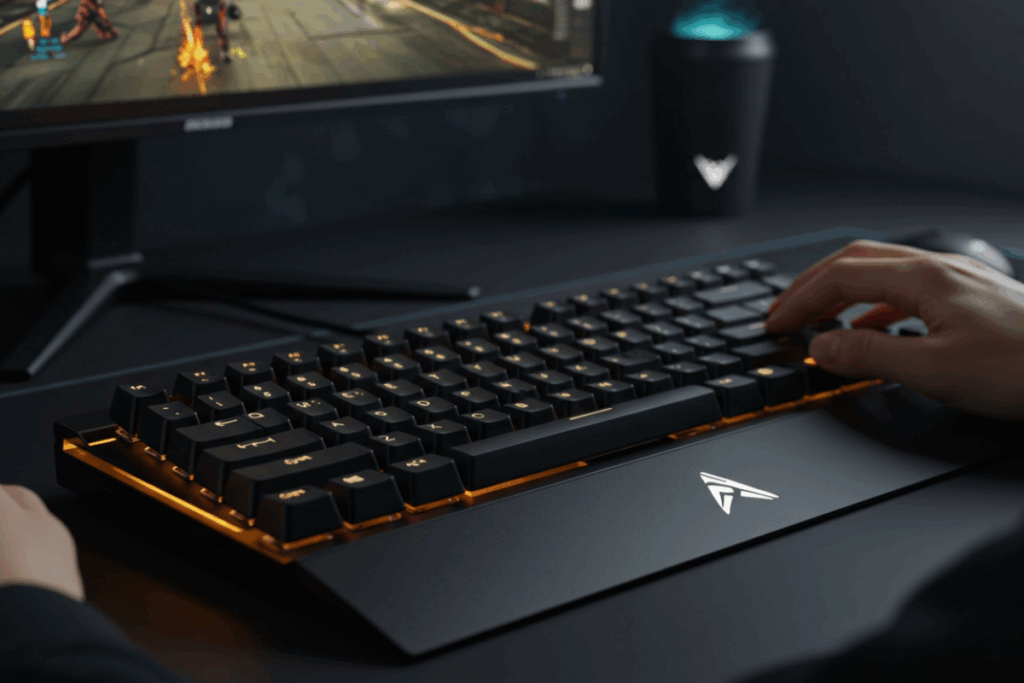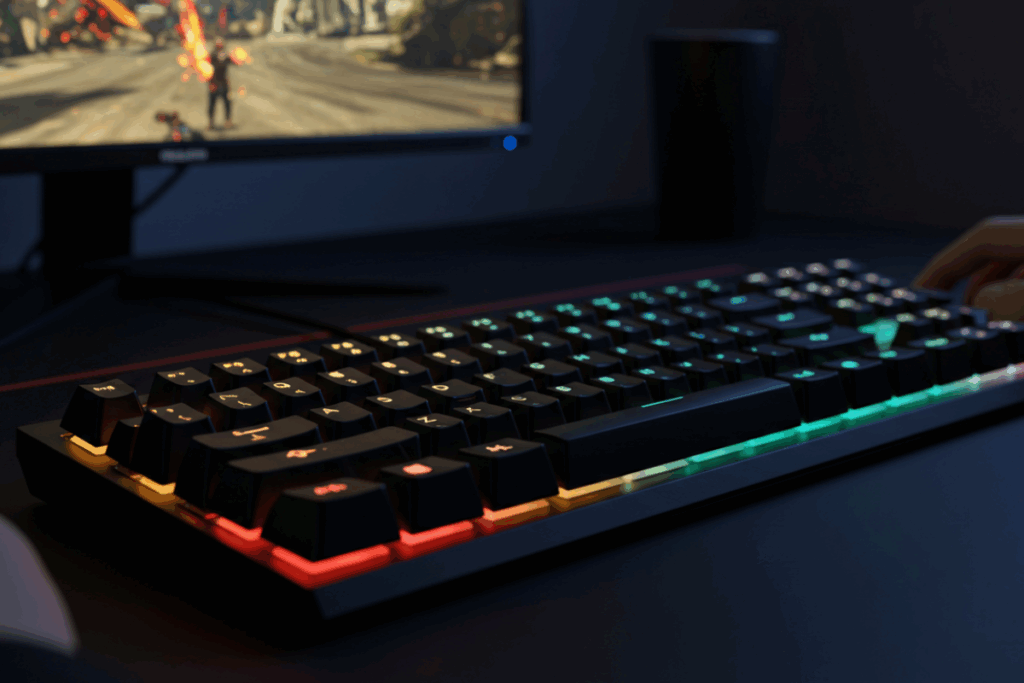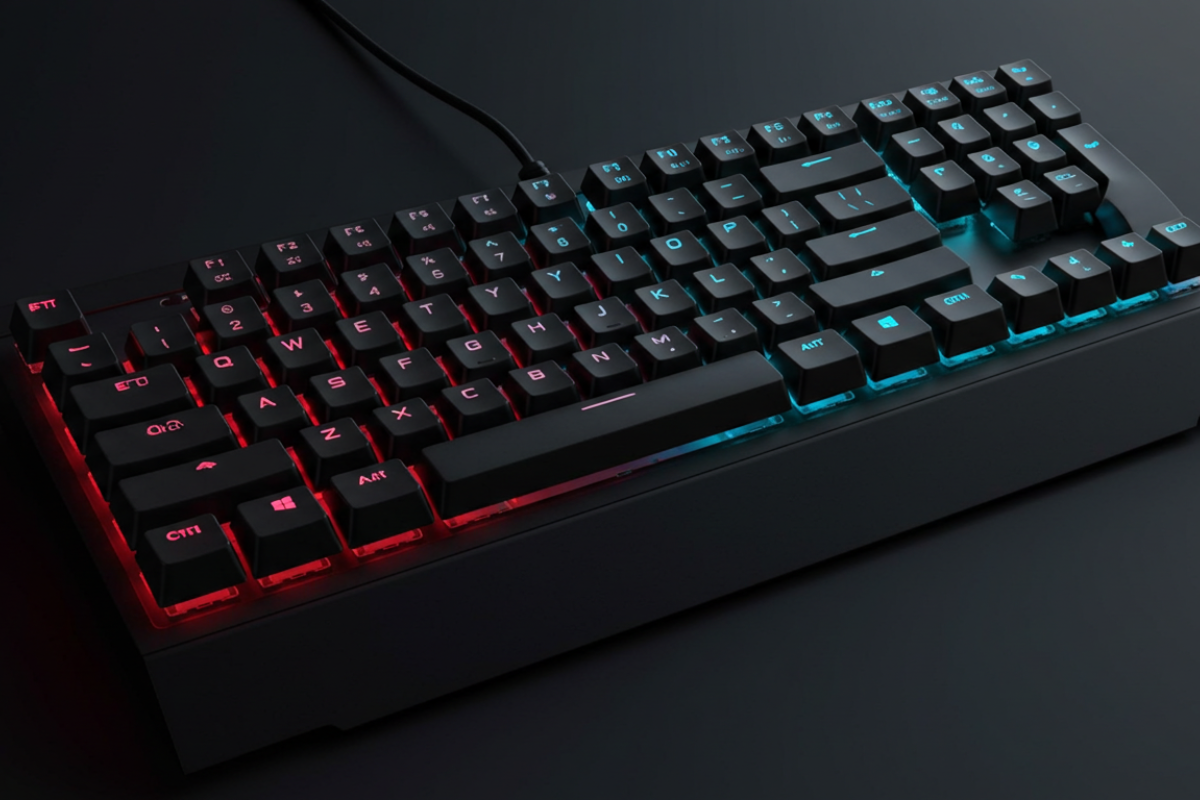Tenkeyless keyboard advantages — I break down why I choose a tenkeyless (TKL) for gaming: the compact form factor, what it drops from a full board, and why that matters for desk space and mouse movement.
I cover ergonomics, faster key reach, switches and performance features like NKRO and anti-ghosting, plus portability, custom mods, and a buying checklist to help you choose. These practical tips are for gamers who want a clean setup and a real edge.
Key Takeaway
- I gain more mouse space with a Keyboards Technology TKL.
- Hands move faster without the numpad in the way.
- TKLs are easy to take to LANs.
- I get a cleaner desk and better posture while gaming.
- A TKL keeps great switches and performance features in a smaller board.
What is a Tenkeyless (TKL) and why its compact form matters
A tenkeyless keyboard removes the numpad but keeps the full alphanumeric and function rows. That puts the layout in the sweet spot between 60%/75% boards and full-size keyboards. At Keyboards Technology, TKLs typically use an 80–87-key layout—compact but feature-rich. The main tenkeyless keyboard advantages here are more desk room, improved mouse placement, and shorter reach between WASD and the number row, while retaining mechanical switches, RGB, and hot-swap options.
What a TKL omits compared to full-size and why that matters
The fundamental omission is the numpad. Benefits I noticed:
- More desk room for a larger mouse area.
- Mouse sits more centered to the monitor, reducing shoulder strain.
- Less lateral reach between hands and keys, speeding reactions.
- Fewer accidental numpad presses in matches.
- A lighter, more portable board for LANs and travel.
- Typically lower price than equivalent full-size models.
I still keep programmability and macro layers—smaller footprint without losing performance.
How TKL compares to other layouts (Full-size / 75% / 60%)
| Layout | Typical Keys | Footprint vs Full-size | Notes |
|---|---|---|---|
| Full-size | 104–108 | 100% | Numpad included |
| TKL (tenkeyless) | 80–87 | ~80–88% | Keeps arrows and function row |
| 75% | 82–84 | ~75–80% | Compact but stacked keys |
| 60% | 61 | ~60% | No arrows or function row by default |
The TKL sits between tiny 60% boards and full-size, keeping more keys than a 60% and offering better ergonomics than full-size.
Quick size facts and the TKL compact form factor
- TKL drops the numpad while keeping the main cluster.
- It often measures a few inches less across the desk—important for mouse space.
- Key count: 80–87 on Keyboards Technology TKLs.
- Weight drops, so it’s easy to grab and go.
- Programmability, RGB, and mechanical switch choices remain available.
Improved desk space and better mouse movement with TKL
Cleaner setups
Swapping to a tenkeyless freed room immediately. Monitor, mouse, and accessories sit neater. I can place a small pad, phone stand, and notepad without crowding. That reduced shoulder tension after long sessions and keeps the setup tidy.
Smoother aim and control
With the TKL, my mouse is closer to center. I use more forearm movement instead of wrist flicks, reducing wrist strain and improving control. Fewer accidental keystrokes and faster access from WASD to the number row translate to quicker reactions in tight plays.
Measured gains I saw:
- Mouse room gain: about 10 cm (4 in) of usable space.
- Centered mouse placement: better posture.
- Cable routing: simpler and cleaner.
- Portability: lighter and easier to transport.
These practical gains underline the main tenkeyless keyboard advantages: space, control, and a cleaner desk.
Ergonomic benefits and faster key reach
Posture and shoulder strain
Removing the numpad let me move the mouse under the monitor center, lowering shoulder stretch and wrist twist. Hands ride straighter and sessions feel more comfortable. Keyboards Technology’s TKL layouts (80–87 keys) deliver this comfort without sacrificing switch choice.
| Metric | Full-size | Tenkeyless (TKL) |
|---|---|---|
| Desk space for mouse | Small | Larger |
| Mouse centered under monitor | No | Yes |
| Shoulder strain | Higher | Lower |
| Portability | Heavy | Light |
Faster key reach
Shorter lateral distance from WASD to number/function rows reduces hand travel and reaction time. Less hand shifting = faster, cleaner inputs. Hot-swap options let me tune switches for speed without buying a new board.
Key practical wins:
- Less hand travel = faster reach.
- Mouse centered = quicker aim adjustments.
- Lower chance of accidental numpad presses = cleaner inputs.
These are real benefits I noticed in LANs and at home: steadier aim, faster combo execution, and easier transport.

Performance: switches, NKRO, and competitive edge
NKRO and anti-ghosting
NKRO (N-key rollover) lets the keyboard register every simultaneous key press—critical for complex combos. Anti-ghosting prevents phantom inputs when many keys are pressed together. Both are essential for competitive play.
Why it matters:
- Confident multi-key combos like WAShift without dropped inputs.
- No phantom presses in clutch moments.
- Reliable macro behavior for skill combos.
| Term | Meaning | Benefit for gamers |
|---|---|---|
| NKRO | All keys can register simultaneously | No missed inputs |
| Anti-ghosting | Prevents phantom key presses | Stops accidental actions |
| Polling rate | How often PC checks the keyboard (Hz) | Higher = lower input lag |
I always check for full NKRO and a high polling rate; Keyboards Technology includes these specs in many TKL models.
Switch choice by playstyle
Switch feel influences aim and tempo:
| Playstyle | Switch type | Why |
|---|---|---|
| FPS | Light linear (low actuation) | Smooth, fast presses |
| MOBA | Tactile (medium actuation) | Clear feedback for timing |
| Hybrid | Medium linear/tactile; hot-swap | Versatile for aim & casting spells |
- Lighter actuation = faster inputs.
- Tactile = clearer confirmation.
- Hot-swap = try switches without soldering.
Competitive specs to watch
- Polling rate: 1000Hz feels snappy.
- NKRO: avoids missed inputs.
- Debounce: short and stable for clean double-taps.
- Build quality and stabilizers: prevent wobble during spamming.
These technical points preserve the competitive edge while delivering the core tenkeyless keyboard advantages.
Customization and portability for LANs and travel
Lightweight and packable
TKLs are lighter and smaller—easy to lift with one hand and fit in a bag. A detachable cable reduces tangles and speeds setup. The TKL’s smaller footprint keeps the mouse centered, cutting shoulder strain and improving aim.
Benefits:
- Smaller footprint = more mouse room.
- Lighter = easier to carry between venues.
- Detachable cable = quicker setup and cleaner routing.
- No numpad = fewer accidental presses.
Mods and hot-swap flexibility
Hot-swap sockets let me swap switches without tools. I add RGB for visual cues, program macros for complex binds, and use foam or plate mods to change sound and feel—useful on the road.
| Mod / Feature | Real benefit |
|---|---|
| Hot-swap switches | Fast swap without tools |
| Programmable macros | One key for complex moves |
| RGB layers | Visual feedback for profiles |
| Case/foam mods | Better sound, less ping |
Portability tips:
- Pack a soft sleeve or small hard case.
- Use a detachable cable stowed separately.
- Leave heavy artisan caps at home.
- Bring hot-swap switches for on-site tuning.
- Add thin foam to dampen sound in public spaces.
- Use on-board macro storage for plug-and-play at events.
What I weigh when buying a TKL: trade-offs, connectivity, and build
Trade-offs to consider
A TKL improves gaming comfort and portability but costs numeric entry speed and dedicated macro keys.
| Trade-off | What I lose | How I cope |
|---|---|---|
| Numpad removed | Fast numeric entry | Use a separate numpad or software hotkeys |
| Fewer macro keys | Instant macros | Use layer programming or on-board macros |
| Smaller layout | Rare key combos missing | Remap keys or use software |
| Portability focus | Slightly less desk stability | Choose a heavier case if needed |
Test a keyboard for a week to see if the trade-offs fit your routine. For spreadsheets, full-size may be better; for gaming and LANs, Keyboards Technology’s TKLs shine.
Buying checklist
- Connectivity: wired for absolute lag-free performance; wireless for tidy setups.
- Stabilizers: pre-lubed or quality stabilizers reduce rattle.
- Materials: aluminum = premium & heavier; plastic = lighter & cheaper.
- Cable management: detachable USB-C and smart routing keep the desk tidy.
- Hot-swap: handy for trying multiple switch types.
- Polling rate / NKRO / debounce: prioritize these specs for competitive play.
| Feature | What I check | Why it matters |
|---|---|---|
| Wired vs Wireless | Polling, battery, USB type | Performance & convenience |
| Stabilizers | Pre-lubed, screw-in | Sound & feel |
| Case material | Aluminum vs plastic | Weight, durability |
| Cable routing | USB-C placement, detachable cable | Desk ergonomics |
Top Tenkeyless Keyboard Advantages (Summary)
- More usable desk space for mouse sweeps.
- Better ergonomics: centered mouse, less shoulder strain.
- Faster key reach and reduced hand travel.
- Lightweight and portable for LANs and travel.
- Keeps competitive features: NKRO, anti-ghosting, high polling rates.
- Full mechanical switch choices and hot-swap options.
- Easy to mod (foam, stabilizers, keycaps) and program macros.
- Cleaner cable routing and neater setup.
- Often better value than equivalent full-size models.
- Versatile for gaming and daily use—one of the strongest tenkeyless keyboard advantages is its balance of features and compactness.
How to pick the right TKL for your playstyle
- Name your primary use: gaming, typing, or both.
- For FPS: prioritize light linear switches, high polling rate, and low actuation.
- For MMOs/MOBAs: consider tactile switches or programmable macro layers.
- Want portability? Pick a lighter case and a detachable cable.
- Want quiet? Choose lubed stabilizers and silent switches.
- Want customizability? Choose hot-swap and strong aftermarket support.
I’ve taken multiple Keyboards Technology TKLs to LANs and kept one at home—both proved the practical tenkeyless keyboard advantages: speed, comfort, and travel readiness.

Conclusion
I settled on the tenkeyless (TKL) as my go-to because it hits a practical sweet spot. I get more mouse space, better ergonomics, and true portability—without losing key features like NKRO, anti-ghosting, and hot-swap support. Shorter hand travel and a centered mouse aren’t fluff—they translate into cleaner inputs and steadier aim.
There are trade-offs: you give up the numpad and some dedicated macros. But layers, external numpads, or on-board macros compensate well. For gaming and LAN life, the benefits in comfort, speed, and desk tidiness make the tenkeyless keyboard advantages a clear win. If you want a cleaner setup and a real edge in play, a TKL from Keyboards Technology is worth trying. Want more guides and reviews?
Frequently Asked Questions
Q: What are the main tenkeyless keyboard advantages for gamers?
A: More mouse space, centered hands, portability, and competitive features like NKRO—Keyboards Technology builds TKLs that travel and perform well.
Q: Do tenkeyless keyboard advantages improve my aim?
A: Yes—more mouse room and centered placement enable smoother sweeps and better forearm control, improving aim.
Q: Can I still use macros without a numpad?
A: Yes—remap keys, use on-board layers, or connect an external numpad. Many TKLs support robust macro programming.
Q: Are TKLs better for LANs and travel?
A: Absolutely—TKLs are lighter, take less bag space, and set up faster with detachable cables.
Q: What are the trade-offs of tenkeyless keyboard advantages for gamers?
A: You lose a dedicated numpad and some macro keys. MMO players may prefer additional macro pads, but most gamers adapt quickly with layers or external peripherals.

